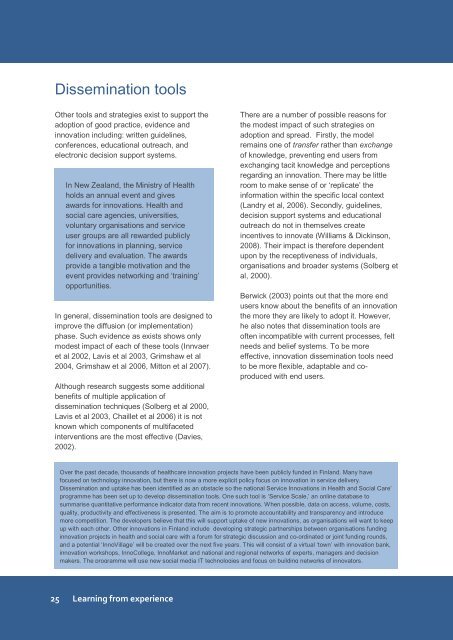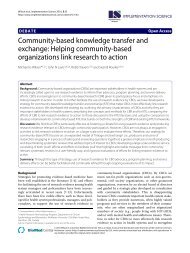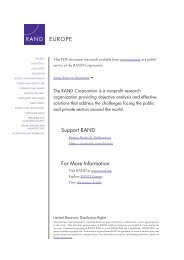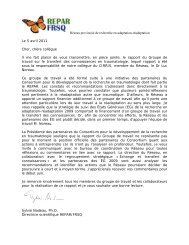Promoting and Embedding Innovation
Promoting and Embedding Innovation
Promoting and Embedding Innovation
Create successful ePaper yourself
Turn your PDF publications into a flip-book with our unique Google optimized e-Paper software.
Dissemination tools<br />
Other tools <strong>and</strong> strategies exist to support the<br />
adoption of good practice, evidence <strong>and</strong><br />
innovation including: written guidelines,<br />
conferences, educational outreach, <strong>and</strong><br />
electronic decision support systems.<br />
In New Zeal<strong>and</strong>, the Ministry of Health<br />
holds an annual event <strong>and</strong> gives<br />
awards for innovations. Health <strong>and</strong><br />
social care agencies, universities,<br />
voluntary organisations <strong>and</strong> service<br />
user groups are all rewarded publicly<br />
for innovations in planning, service<br />
delivery <strong>and</strong> evaluation. The awards<br />
provide a tangible motivation <strong>and</strong> the<br />
event provides networking <strong>and</strong> „training‟<br />
opportunities.<br />
In general, dissemination tools are designed to<br />
improve the diffusion (or implementation)<br />
phase. Such evidence as exists shows only<br />
modest impact of each of these tools (Innvaer<br />
et al 2002, Lavis et al 2003, Grimshaw et al<br />
2004, Grimshaw et al 2006, Mitton et al 2007).<br />
Although research suggests some additional<br />
benefits of multiple application of<br />
dissemination techniques (Solberg et al 2000,<br />
Lavis et al 2003, Chaillet et al 2006) it is not<br />
known which components of multifaceted<br />
interventions are the most effective (Davies,<br />
2002).<br />
There are a number of possible reasons for<br />
the modest impact of such strategies on<br />
adoption <strong>and</strong> spread. Firstly, the model<br />
remains one of transfer rather than exchange<br />
of knowledge, preventing end users from<br />
exchanging tacit knowledge <strong>and</strong> perceptions<br />
regarding an innovation. There may be little<br />
room to make sense of or „replicate‟ the<br />
information within the specific local context<br />
(L<strong>and</strong>ry et al, 2006). Secondly, guidelines,<br />
decision support systems <strong>and</strong> educational<br />
outreach do not in themselves create<br />
incentives to innovate (Williams & Dickinson,<br />
2008). Their impact is therefore dependent<br />
upon by the receptiveness of individuals,<br />
organisations <strong>and</strong> broader systems (Solberg et<br />
al, 2000).<br />
Berwick (2003) points out that the more end<br />
users know about the benefits of an innovation<br />
the more they are likely to adopt it. However,<br />
he also notes that dissemination tools are<br />
often incompatible with current processes, felt<br />
needs <strong>and</strong> belief systems. To be more<br />
effective, innovation dissemination tools need<br />
to be more flexible, adaptable <strong>and</strong> coproduced<br />
with end users.<br />
Over the past decade, thous<strong>and</strong>s of healthcare innovation projects have been publicly funded in Finl<strong>and</strong>. Many have<br />
focused on technology innovation, but there is now a more explicit policy focus on innovation in service delivery.<br />
Dissemination <strong>and</strong> uptake has been identified as an obstacle so the national Service <strong>Innovation</strong>s in Health <strong>and</strong> Social Care‟<br />
programme has been set up to develop dissemination tools. One such tool is „Service Scale,‟ an online database to<br />
summarise quantitative performance indicator data from recent innovations. When possible, data on access, volume, costs,<br />
quality, productivity <strong>and</strong> effectiveness is presented. The aim is to promote accountability <strong>and</strong> transparency <strong>and</strong> introduce<br />
more competition. The developers believe that this will support uptake of new innovations, as organisations will want to keep<br />
up with each other. Other innovations in Finl<strong>and</strong> include developing strategic partnerships between organisations funding<br />
innovation projects in health <strong>and</strong> social care with a forum for strategic discussion <strong>and</strong> co-ordinated or joint funding rounds,<br />
<strong>and</strong> a potential „InnoVillage‟ will be created over the next five years. This will consist of a virtual „town‟ with innovation bank,<br />
innovation workshops, InnoCollege, InnoMarket <strong>and</strong> national <strong>and</strong> regional networks of experts, managers <strong>and</strong> decision<br />
makers. The programme will use new social media IT technologies <strong>and</strong> focus on building networks of innovators.<br />
25 Learning from experience
















